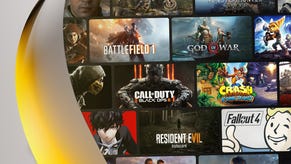How accessible are game engines, and how much is still to be done?
There has been been significant investment in adaptable controllers, awareness campaigns, and more, but how accessible is the tech behind the games themselves?
Game development is, in some ways, more accessible than ever. Between the ease-of-use of engines like RPG Maker to the release of titles like Game Builder Garage that gamify the act of development itself, there are countless ways into game development that do not require previous experience of coding or design.
"One of the biggest hurdles in video games accessibility is the tooling"Ines Robin
The opportunity for creation with engines like Unreal, Unity and more is enormous. But – just as with issues with accessible gaming itself – there are still obstacles to be overcome when it comes to making those engines available for everyone to use.
That has huge implications for the games industry: the 2021 developer satisfaction survey from the International Game Development Association found that 29% of respondents to the survey considered themselves to have a disability of some kind.
Cameron Keywood is studio director of Wales-based DragonCog Interactive. He explains that, given wider recognition of the commercial and moral imperatives with making game dev accessible, larger engines are making it a priority.
"Mainstream engines like Unity and Unreal Engine have made significant strides in integrating accessibility features, providing support for screen readers, keyboard shortcuts, and customisable interfaces," he says.
"These engines also have robust documentation and tutorials on how to implement accessibility features in games developed using their engines."
He also notes that, while larger engines typically have the resources to implement accessibility features for developers, indie engines often do not. That is a view backed up by Cari Watterton, senior accessibility designer at studio Rebellion, who states that the variety of technical support varies wildly by engine.
"Indie engines tend to offer more bespoke solutions. For example, there have been some game engines which have been designed specifically for blind developers but are often limited to creating audio games. In comparison, mainstream engines cater to building a variety of game genres, so there is often more broad support for accessibility features."
Ines Robin, client developer at Space Ape Games says that the lack of internal resources is often the primary reason for accessibility features not getting implemented, stating: "One of the biggest hurdles in video games accessibility is the tooling. A well meaning team might not be able to achieve their accessibility goals if the tooling is too difficult to obtain, because we're all working on tight deadlines and budget."
"Accessibility in development is lacking… and it is difficult to find help for developers"Jess Molloy
Clay John is a developer for Godot, a primarily volunteer-developed engine. He acknowledges that a lack of resources often snowballs, making it harder to include accessibility features in the long term.
"While accessibility is important to us, we lack the person-power and experience to do everything that we know is possible. For clarity, we don't have an accessibility expert on the team.
"Our current team size is ten people. We have a few people in the ecosystem looking for more accessibility tools – screen-reader support being the biggest one – but they tend to lack the expertise to contribute. Hopefully having proper screen reader support will help resolve the chicken and egg problem and encourage more people with expertise to help out."
He does, however, remain optimistic that accessibility for game developers is a rising concern among the industry, stating that it was a recurrent and high-profile issue discussed at this year’s Game Developer Conference.

Inclusion and representation
However, there is a sense among some developers that even the most well-meaning accessibility features are a secondary concern to the creators of game engines. That, in turn, limits their effectiveness when they are implemented.
Jess Molloy is a game designer and certified accessible player experience practitioner (an industry course offered by Accessible Games and the AbleGamers charity). She explains that even the larger game engines sometimes skirt or avoid making their tools accessible: "Unfortunately accessibility in development is lacking… and it is difficult to find help for game developers."
She notes that, often, that help has to come from third parties: "Popular game engines have plugins to make their created content more accessible to assist developers in complying with CVAA requirements for blind users."
She cites plugins like ReadSpeaker, as well as a Speech Engine SDK for custom game engines, as examples of third parties having to shore up the inbuilt capabilities of some game engines.
Phoebe Hesketh is a researcher and founder of education and advocacy group Take a Mo. She explains: "Accessibility isn't something you try to apply once or can bolt on when the software is complete. It's something that needs continuous attention, application, and feedback. Feedback is especially important as end-users with disabilities should be involved in the analysis and review of accessibility features."
As a result, advocates note that including people with disabilities in the development process from the start is vital. Marijn Rongen is a member of the team at Can I Play That, which tracks the accessibility options within games. He says that doing so confers benefits to the makers of engines as well as their end-users.
"Accessibility isn't something you try to apply once or can bolt on when the software is complete"Phoebe Hesketh
"Having disabled people on the team can help bring continued awareness to accessibility, and help include accessibility earlier in the design and development process, where it costs less effort and money to integrate.
"If the major engine and development tool creators, like Unreal, Unity, etc. are accessible, that makes the most impact as fewer bespoke solutions will need to be invented for developers at the companies that use these tools."
It is a point of view backed up by Space Ape Games' Robin, who explains that making game dev accessible means that the games they produce are typically more accessible in turn, broadening their appeal.
"The more a product is accessible, the larger the customer base," she says. "More money for the engine makers, but also, a more diverse development team means a more creative and accessible end product which in turn will be beneficial to the whole player base."
To demonstrate the scale of what is being left on the table, UKIE currently estimates that there are over 100,000 players who could form new audiences for games from disabled communities.

Technical requirements
The issue of engine accessibility for game developers is inextricably tied with wider considerations about the constraints and pressures placed upon game developers. While the 21st Century Communications and Video Accessibility Act (CVAA) is credited by organisations including Accessibility Unlocked as helping to ensure that the technical needs of disabled developers are considered, it is far from a silver bullet.
Take a Mo's Hesketh, for example, notes that game development as a whole is often an arduous process that is particularly difficult for some developers with disabilities.
"Third-party developers can help make the tools accessible, while producers and studios can make the work environment accessible [by] allowing for part-time or workshare, allowing for remote work, providing more adjustments, and being explicit about these opportunities for developers with disabilities."
Ensuring that all aspects of game development are accessible also means that a wider variety of lived experiences can be considered when creating new tools for developers. Dom Shaw is EDI coordinator for the trade body UKIE. He explains: "When developers have access to tools that cater to diverse needs, they can explore novel ideas and methodologies that might otherwise remain unexplored. Features such as keyboard shortcuts, customisable interfaces, and comprehensive documentation can enhance productivity and workflow efficiency for all developers, not solely those with disabilities."
Beyond games themselves, asset creation within engines like Unreal has become part of non-gaming activity as brands create 3D models of their products for use in AR and virtual spaces. In 2022, the Institute of Practitioners in Advertising teamed up with Epic Games to create an introductory course to game dev for brands looking to do just that.
But in order for engines to live up to their promise – commercially and artistically – they need to be accessible to developers with a variety of needs. While progress has been made there is still a gulf to be crossed before that promise is realised.







.jpg?width=291&height=164&fit=crop&quality=80&format=jpg&auto=webp)

